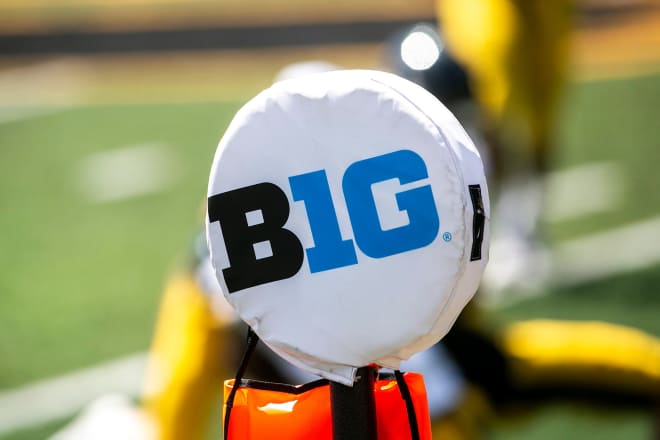Nine-game Big Ten schedule here 'for foreseeable future'

MORE: Purdue AD Mike Bobinski: 'We've talked to two' collectives | NIL collective coming, will be built 'Purdue way' | Purdue AD Mike Bobinski 'perfectly OK with continuing' divisions
There are few certainties in life. One appears to be this: The Big Ten will continue to play a nine-game league schedule.
“For the foreseeable future,” said Purdue A.D. Mike Bobinski. “I don't see any change on that at all. I mean, I just don't. … There are lots of good reasons not to do it, not to change on the nine.”
The Big Ten moved from an eight-game league slate to a nine-game menu in 2016. But with the college football horizon ripe with tumult and peppered with unknowns, now doesn't appear to be a time for change.
• What will the next iteration of the College Football Playoff look like?
• How will name, image and likeness/collectives sort out?
• Will Power Five leagues break away from the NCAA?
“I think you want to always pay attention to what you think we would collectively believe is the best structure and arrangement for the Big Ten,” said Bobinski. “Everybody looks at it through their specific lens, which you know is natural, that's human nature. What does this mean for us here at Purdue or for somebody else sitting in my chair in some other school?
“But I think our jobs at some level is to not only protect your own interest, but also to try to position the overall league as best we can. And I think what we came to a little bit in Phoenix (during college football meetings earlier this month) is that there are so many moving parts right now.”
On and on it goes, as big questions loom over the sport. This isn’t the time for hasty decisions.
“The SEC is going to expand (with Oklahoma and Texas in 2025),” said Bobinski. “They've been at eight conference games for a long time. Lots of speculation, and I think rightfully so, coming out of their conversations that that's not where they're going to be going forward. They're going to be at nine or maybe even 10. So, I think nine is a sure thing when you got 16 teams. If you only play eight, you got half the league you don't even see.
“I think there are lots of things that caused us to say maybe we don't need to rush to it other than just start thinking about how we might want to position ourselves going forward. And I think that's the goal, is to be ready as we start to know more about what the environment is gonna look like. We can then take whatever action feels like the best thing for the Big Ten in general.”
Last August, the Big Ten joined forces with the Pac-12 and ACC to form The Alliance, described at the time as a "collaborative approach surrounding the future evolution of college athletics and scheduling."
But nothing substantive has come from the union. And, certainly, any notion of Big Ten schools re-doing non-league schedules to work in ACC and Pac-12 schools—or falling back to eight-game league schedules to accommodate non-conference games with the ACC and Pac-12—appears to be folly.
“(The Alliance is) not dead,” said Bobinski. “There will still be things that we collaborate with those leagues on because we share a lot of the same thoughts and values and philosophies. But I don't know that you're going to see anything substantive in terms of scheduling because there's just not that much room in your schedule to start to carve out guaranteed games against other leagues.”
Among the power trio of leagues, the Big Ten has the most reason to move cautiously and with prudence.
“It sounded good in concept,” said Bobinski. “If there was more room and flexibility, yeah, that sounds great. But at the end of the day, the Big Ten, I think, by everyone's estimation, we had more at risk than the other two leagues in terms of adjusting our plan and our schedule to fit them in.
“We've intentionally slowed that one down. And everybody understands. They all get it. They all understand that we've got a lot more on the table right now than they do in terms of media rights deals and other things.”
The Big Ten is on the precipice of finishing negations on what’s expected to be a jaw-dropping TV deal which would begin in 2023 and could be worth a record-setting $1 billion per season.
One dynamic that could change for the Big Ten in the near future: elimination of the East-West divisional construct. And if that happens, a new conference scheduling model will likely need to be developed.
“We've got a skilled scheduling consultant that works with us, that's really good,” said Bobinski. “And he can spit out every option that you can imagine. And so we've looked at a couple of things, two protected (opponents). Three protected. I don't think anybody has settled on any one as this is the best way to go. And nor have we decided that we're not going to play divisions. It's still very much right now at the exploratory and conversation stage.”
There may be a push to allow a school to visit and play host to each Big Ten foe during a four-year period.
“It's important in your league to see as many teams as you can,” said Bobinski. “That's one of the arguments for not having divisions, is that you then have a chance to rotate through all the teams around the league on a more regular basis. That, to me, is probably the most compelling thing, is that you get a chance to see other people in your stadiums and you get to visit, take your team to play in environments that ordinarily they may not see.
“Guys may go through a whole career and never compete against certain schools or never see their campus or all those kinds of things. So, I think that's worth thinking about. Whether or not that's a reason to make a move remains to be seen, but I think it's certainly worth thinking about.”
Another possible dynamic that would impact future scheduling: Big Ten expansion.
"I think the only way you expand is if you have prospective league members that add value, that move the needle in a real way, in a substantive way," said Bobinski. "Again, we're in a really good spot in the Big Ten. We don't need numbers for numbers sake.
"But if there were potential league members that are sort of the spirit of what the Big Ten's about, the academic profile and sort of the strength of the institution, and they brought athletic programs, football programs, basketball programs, that added real value, I think anything's possible. But there's nothing active on that front at this point."
Membership Info: Sign up for GoldandBlack.com now | Why join? | Questions?
Follow GoldandBlack.com: Twitter | Facebook | YouTube
More: Gold and Black Illustrated/Gold and Black Express | Subscribe to our podcast
Copyright, Boilers, Inc. 2022. All Rights Reserved. Reproducing or using editorial or graphical content, in whole or in part, without permission, is strictly prohibited.

